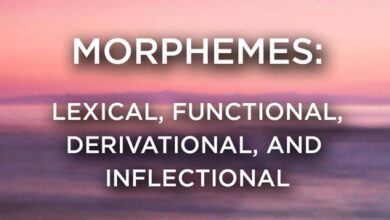morphology and syntax
Morphology and syntax
The grammar is subdivided into morphology and syntax . The morphology is the science that studies the accident (change) grammar. The term comes from the Greek morphē form and science logos . The word syntax comes from the Greek syntax , which means in order. This means that it teaches to coordinate and match the words to form the sentences.
The syntax corresponds to studying the context as such, that is, the groupings of related or related words. The syntax studies everything that is linked to the sentence, the relationships of the words in the sentence, the order of the words.
But it was not always like this. In the early nineteenth century morphology was studied in general, the syntax was developed later. Then morphology studied only forms, while syntax was devoted to the study of the meaning of those forms and prayer in general. Thus, grammar times, for example, were studied in different parts of grammar: their forms in morphology and their meanings in syntax.
Current morphology studies not only grammatical forms, but their meanings as well.
Not all linguists consider the division of morphology and syntax logical. F. de Saussure did not separate them in his study.
Summarizing what has been said, we underline that morphology studies words and their forms, syntax the relationships between these words. But here there are many exclusions. For example, the decline of the Russian noun expresses the relationships between words but is studied in morphology. At the same time, some temporary forms ( I will read ) are studied in morphology, although they are also about the relationships between words. Thus it is considered that in morphology all types of word forms and even forms that are linked to the expression of relations between words are analyzed. Morphology extracts words from their context to classify them into different groups according to the functions they are capable of.
Despite all the difficulties, the division between morphology and syntax is fair and based on the methodical convenience of examining language from different points of view. When morphology classifies words as parts of the sentence, it often uses functional or syntactic concepts. When the syntax establishes the rules of concordance, it does nothing more than adjust the system of grammatical forms studied in morphology. Estp shows us a reciprocal penetration of the two parts into which the grammar is divided.
Basic elements of morphology
The basic element of the morphological level of the language is considered the morpheme: the smallest sequence of phonemes endowed with meaning, the least significant part of the word. It is not the same as a syllable, which is based on breathing and is the object of phonology. For example, the word height has 3 syllables (al-tu-ra) but two morphemes (alt-ura) .
The morpheme can coincide in many cases with a word: sun, sea, light. We speak in this case of radical words. The relevant feature of the word is independence and separability, that is, the possibility of isolating ones from otrus within the body of speech through a pause. In traditional writing these pauses correspond to the spaces that graphically isolate the words. Morpheme is part of a word, but there are cases that put us in doubt or hesitation. As for articles, auxiliary verbs, particles, syntactic relation words, unstressed pronouns, etc. Are they morphemes or independent words? The problem of the distinction between the autonomous word and morpheme as its part still provokes numerous discussions in contemporary linguistics. The study of morphemes, their classes and their organization in the body of words attends morphology.
Morphemes are classified into three essential classes.
1. Lexical morphemes.
Traditionally they are called radical or root. They can independently express the determined meaning: cas-a, man, e-enter, alt-o . They carry in themselves the fundamental meaning of the word.
Some authors disagree with the determination of lexical morphemes and exclude the roots of the morpheme class, considering that morphemes are only the grammatical elements of the word.
2. Grammar morphemes.
They are called flexive morphemes or flexions and are added to lexical morphemes without changing their meaning. They are morphemes that constitute the verbal paradigm (number morphemes »person, time, mode), number and gender morphemes of the name: cant-a-mos, dec-ia-n, baj-o, roj-a, iibr-os , etc.
Zero flexion is the significant absence of formal flexion, which carries its grammatical meaning. For example, in the opposition on Monday – on Mondays the plural form has the zero morpheme O corresponding to the meaning of the plurality,
3. Morphemes of word formation.
Derivative morphemes are called affixes and have a predominant lexical character, since they form new words.
Prefixes , morphemes preceded to the root, express the relations of place, time, repetition, denial, aspect: re-pass, sub-divide, over-put, dea-do, in-cult, ante-yesterday, between-act , etc.
Interfixes are affixes that join two roots in compound words. This structure is called composition. The compound words belong to almost all lexical-grammatical categories: diec-i-six, col-i-flor, verd-i-negro, carn-i-ficar .
Infixes are found in the mited root. They are affixes that on one occasion appear, on another – they disappear: break – broken, choose – elected, spread – diffuse .
Confixes are combinations of a prefix with a suffix in the structure of words called parasynthetics: heartless, dirty, sweetened. Such a method of forming words has acquired the denomination of parasynthesis. Note that in classical parasynthesis, the two procedures can be solidary in one act – derivation and composition: beggar, self-absorption, cincomesino, clothing .
